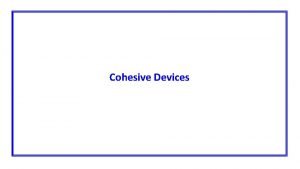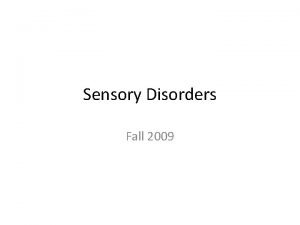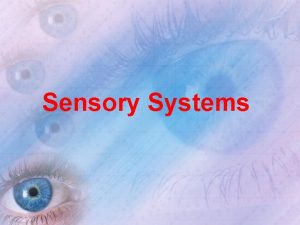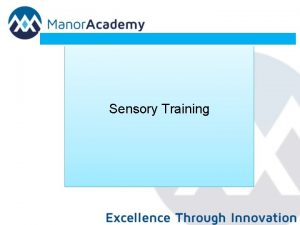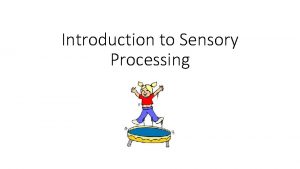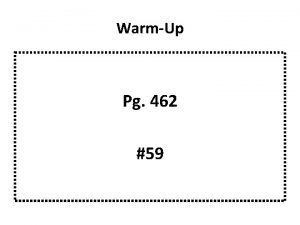Sensory Differences GLHS LINKS WarmUp What is sensory


















- Slides: 18

Sensory Differences GLHS LINKS

Warm-Up • What is sensory processing disorder?

Warm-Up • Sensory processing disorder is a neurological disorder that causes difficulty-processing information from the senses: sight, hearing, touch, smell, taste, the sense of movement, and the positional sense. • Causes the brain to process the information in an unusual way • May cause distress or confusion making it difficult to process and act on information received through the senses • Results in a struggle to perform everyday tasks.

Goals: • Participants will be able to: -Understand the various senses and how they contribute to everyday functioning -Understand sensory processing disorders -Recognize common sensory differences in individuals with ASD -Be able to explain how sensory processing differences might affect persons with ASD in terms of behavior, learning, and performance

Importance of Sensory Input • Sensory input is needed to maintain life functions. • That "just right" amount of sensory input and our brain's processing of it that makes us appropriately alert so we can engage in meaningful life activities during the day and yet allows us to peacefully sleep at night. • Extreme sensory input for extended lengths of time can have detrimental effects on our well being, making us feel overwhelmed and frightened, leading to behavior that is either frenzied or causes us to shut down. • Too little sensory input can make us dull, lifeless, and disengaged.

Our Five Senses • Most people are familiar with at least five basic senses. • Hearing (auditory) • Sight (visual) • Touch (tactile) • Taste (gustatory) • Smell (olfactory).

Two additional senses Vestibular & Proprioception

Vestibular • Coordinates the movement of our body, head, and eyes. • The brain in turn responds to the movement through space and body position. • Allows us to balance, throw a ball, or stumble without falling. • It maintains muscle tone, helps coordinate the two sides of the body, and enables us to hold our head up against the force of gravity.

Proprioception • Uses information from the muscles and joints to give us an awareness of our body position. • Tells us where our arms and legs are in space without directly looking at them. • Proprioception helps adjust body position to prevent us from falling out of a chair, and allows us to manipulate a pen or hairbrush.

What is Sensory Processing Disorder? • The inability to modulate, discriminate, coordinate, or organize sensations effectively. • Can affect the way we learn, our behavior, movement, relationships, and how we feel physically. • Person with a sensory processing disorder, processes sensory input differently from most people. Can be under or over responsive to sensory input.

Overly Responsive vs. Under Responsive Overly Responsive Under Responsive • Often unable to filter routine experiences/stimuli: lights, sounds, smells, touch, etc. • Can interpret these sensory experiences as painful and overwhelming. • May not appear to notice or respond to normal stimuli, • Filters so much of stimuli. • May not process pain when injured, notice extreme hot and cold, loud noises, etc

Regulating Input • Some also have difficulty regulating their responses to input so their behavioral responses are unpredictable from hour to hour and day to day. • For example, in the morning a person may fall and injure himself without noticing but by the afternoon he is agitated over the small tag in the back of his shirt, demanding that someone remove it because it hurts.

Who’s Affected? • Abnormalities in processing incoming sensations such as light, sound, touch, taste, pain, smell, movement, or temperature are reportedly experienced by 70 -95% of the ASD population

What does it look like • Go to www. autisminternetmodules. org & watch video under Sensory Differences (2: 36 minutes) (Page 11 in module)

Case Study: Sonya • Go to www. autisminternetmodules. org & read about Sonya. (Page 16 of module)

Cumulative Effect of Sensory Input • Behavioral responses to sensory experiences can appear to fluctuate from hour to hour and day to day. • What is overwhelming one day may not have the same effect the next day. • Illness, fatigue, stress, and hunger can all impact our response to sensory input. • It may take numerous sensory experiences for an under-responsive child to pay attention or very few for an overly responsive child to reach the breaking point. • Such variance can make it difficult to determine which type of sensory input is impacting the child.

Summary • Our senses give us information about the world around us; our brain processes the sensory input, and we respond based upon how we process that information. • Our senses keep us safe, provide us pleasure, and help us function. Individuals on the autism spectrum may not receive, process, and react to sensory stimuli the same way as neurotypicals. • Overly responsive to sensory experiences in the environment. • Under-responsive to sensory experiences in the environment. • May benefit from services from an occupational therapy practitioner who can provide assessment and intervention strategies to help them manage their sensory differences and improve their access to successful home, school, social, and work experiences.

Autism Internet Modules. http: //www. autisminternetmodules. org















